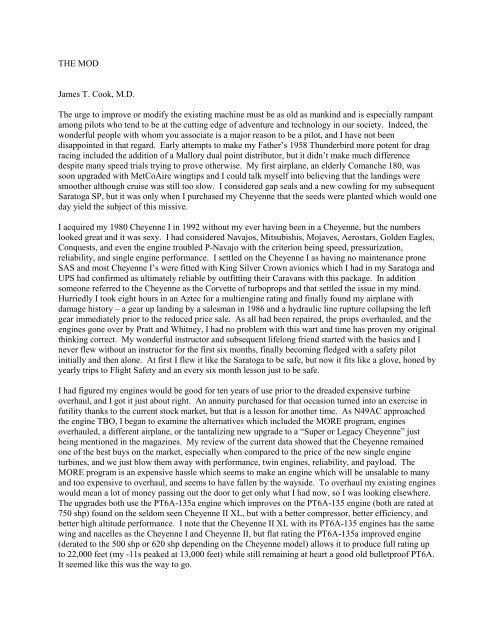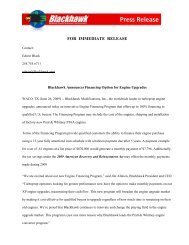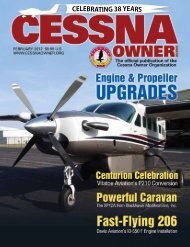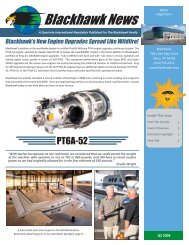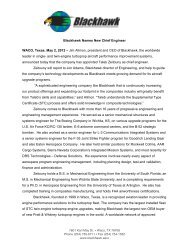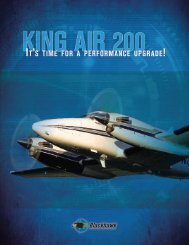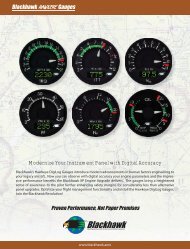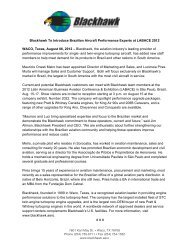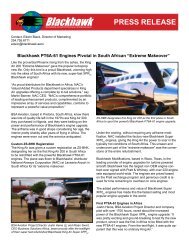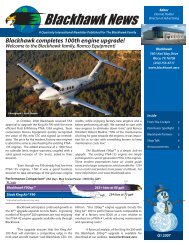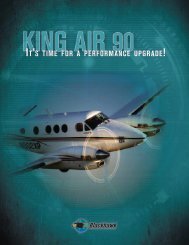Cheyenne Magazine - Blackhawk Modifications, Inc.
Cheyenne Magazine - Blackhawk Modifications, Inc.
Cheyenne Magazine - Blackhawk Modifications, Inc.
- No tags were found...
Create successful ePaper yourself
Turn your PDF publications into a flip-book with our unique Google optimized e-Paper software.
THE MODJames T. Cook, M.D.The urge to improve or modify the existing machine must be as old as mankind and is especially rampantamong pilots who tend to be at the cutting edge of adventure and technology in our society. Indeed, thewonderful people with whom you associate is a major reason to be a pilot, and I have not beendisappointed in that regard. Early attempts to make my Father’s 1958 Thunderbird more potent for dragracing included the addition of a Mallory dual point distributor, but it didn’t make much differencedespite many speed trials trying to prove otherwise. My first airplane, an elderly Comanche 180, wassoon upgraded with MetCoAire wingtips and I could talk myself into believing that the landings weresmoother although cruise was still too slow. I considered gap seals and a new cowling for my subsequentSaratoga SP, but it was only when I purchased my <strong>Cheyenne</strong> that the seeds were planted which would oneday yield the subject of this missive.I acquired my 1980 <strong>Cheyenne</strong> I in 1992 without my ever having been in a <strong>Cheyenne</strong>, but the numberslooked great and it was sexy. I had considered Navajos, Mitsubishis, Mojaves, Aerostars, Golden Eagles,Conquests, and even the engine troubled P-Navajo with the criterion being speed, pressurization,reliability, and single engine performance. I settled on the <strong>Cheyenne</strong> I as having no maintenance proneSAS and most <strong>Cheyenne</strong> I’s were fitted with King Silver Crown avionics which I had in my Saratoga andUPS had confirmed as ultimately reliable by outfitting their Caravans with this package. In additionsomeone referred to the <strong>Cheyenne</strong> as the Corvette of turboprops and that settled the issue in my mind.Hurriedly I took eight hours in an Aztec for a multiengine rating and finally found my airplane withdamage history – a gear up landing by a salesman in 1986 and a hydraulic line rupture collapsing the leftgear immediately prior to the reduced price sale. As all had been repaired, the props overhauled, and theengines gone over by Pratt and Whitney, I had no problem with this wart and time has proven my originalthinking correct. My wonderful instructor and subsequent lifelong friend started with the basics and Inever flew without an instructor for the first six months, finally becoming fledged with a safety pilotinitially and then alone. At first I flew it like the Saratoga to be safe, but now it fits like a glove, honed byyearly trips to Flight Safety and an every six month lesson just to be safe.I had figured my engines would be good for ten years of use prior to the dreaded expensive turbineoverhaul, and I got it just about right. An annuity purchased for that occasion turned into an exercise infutility thanks to the current stock market, but that is a lesson for another time. As N49AC approachedthe engine TBO, I began to examine the alternatives which included the MORE program, enginesoverhauled, a different airplane, or the tantalizing new upgrade to a “Super or Legacy <strong>Cheyenne</strong>” justbeing mentioned in the magazines. My review of the current data showed that the <strong>Cheyenne</strong> remainedone of the best buys on the market, especially when compared to the price of the new single engineturbines, and we just blow them away with performance, twin engines, reliability, and payload. TheMORE program is an expensive hassle which seems to make an engine which will be unsalable to manyand too expensive to overhaul, and seems to have fallen by the wayside. To overhaul my existing engineswould mean a lot of money passing out the door to get only what I had now, so I was looking elsewhere.The upgrades both use the PT6A-135a engine which improves on the PT6A-135 engine (both are rated at750 shp) found on the seldom seen <strong>Cheyenne</strong> II XL, but with a better compressor, better efficiency, andbetter high altitude performance. I note that the <strong>Cheyenne</strong> II XL with its PT6A-135 engines has the samewing and nacelles as the <strong>Cheyenne</strong> I and <strong>Cheyenne</strong> II, but flat rating the PT6A-135a improved engine(derated to the 500 shp or 620 shp depending on the <strong>Cheyenne</strong> model) allows it to produce full rating upto 22,000 feet (my -11s peaked at 13,000 feet) while still remaining at heart a good old bulletproof PT6A.It seemed like this was the way to go.
There were two outfits doing the modifications when I investigated, T-G Aviation in Canada and theAircraft Restoration Company (ARC) in Provo, Utah, differing in the conversion props with T-G using athree blade prop and ARC using a newly designed Hartzell four blade prop which has a TBO of 4000hours or 72 months. I received literature from both groups and decided to go with the group at ARC, butI was hesitant to commit in such a crummy stock market.For six months I tormented the gentlemen in Provo with questions about experience, performance,reliability, how long it would take, and things of that ilk. The cork was bobbing but I had not taken thebait, still circling and trying to make up my mind. I talked with a wonderful gentleman in Nebraska whohad modified his <strong>Cheyenne</strong> I using T-G and he was ecstatic about the performance and new found highaltitude capability. I talked with an engineer at Hartzell who discussed the four blade prop with me andthe fact it is used on certain King Airs- he emphasized its reliability, efficiency, and safety. Emails cameand went and each week as it seemed I always came up with a new series of questions, patiently answeredby my long distance friends in Utah. Finally ARC did a wonderful thing – they set a deadline of twoweeks on the price which was precipitated by Pratt and Whitney announcing a significant price increaseon the new engines. The cork went under as I took the bait and ran, not looking back, and the difficultdecision was made in the middle of August and sealed with a check.The longer lead time item was the Hartzell props and they were ordered forthwith with delivery in aboutsix weeks, so it seemed that the best time for the aircraft to go out was late September. I arranged withthem to accomplish my Events while changing the engines just to make everything work together, andthat proved to be a reasonable decision. I wheedled a few days off from work and ordered my tickets onDelta for the round trip, achieving a reasonable price of $900 from Panama City round trip. The day ofdeparture loomed cloudy and overcast thanks to Hurricane Isidore coming up from the Gulf, but aftertaxiing out at 7:30 AM I climbed to FL200 with some bumpiness in IMC until the Mississippi River whenI burst into the clear. All the big boys up high were complaining about the turbulence, so I had selectedan ideal compromise, achieving a TAS of 240 knots with the Ram Air Intakes and Speed Stacks byAmerican Aviation. The green soon faded to the browns of the Texas panhandle and Amarillo appearedafter four flying hours as a verdant patch where a LearJet was doing touch and goes at the airport. Theonly FBO was excellent with fast turnaround while a breakfast at the adjacent restaurant lived up to itsrecommendation by my friend there the week before. Departure saw N49AC vectored over an MOA bystruggling up to FL260 where I could just barely go 200 knots, but then I returned to FL220 for the rest ofthe trip over the tortured terrain of the continental divide and the Rockies.Provo is in a beautiful valley of the Wasatch Mountains on the side of Lake Utah, a freshwater lake justsouth of the Great Salk Lake, with the uncontrolled Provo airport on the Lake.As I landed at 1:30 PM I noted the plethora of Katanas indicating an active training program and indeedProvo is the home of Brigham Young University. I taxied up and down the flight line looking for ARC tono avail, and finally stopped at the main FBO where I felt a chill when the linesman said he had neverheard of them. Inside, however, the conference room was reserved for us and the wonderful Tom Suttonsoon arrived unaware of the curse that always makes me early for appointments. Tom was retired AirForce (C-130s) who pulled a couple of Corporations out of the ditch, but then retired to Provo to be withhis family of eight sons and two daughters and to return to aviation- and what else is there in life? Wewent over to the ARC hangar where their modified <strong>Cheyenne</strong> II was located along with the P-51 replicabuilding by Jan Fronk with a Chevrolet 502 engine and about two more years of work was needed. Thehangar also sported a lot of equipment, a StarDuster, and was immaculate, confirming that I was in goodhands. The other honcho of ARC was Dave Fronk who is a LearJet guru who was out of town on a repairmission, but his real love is for the <strong>Cheyenne</strong> and it shows. I was shown the hangar next door with thered modified real Mustang P-51 which had just won the Reno Air Races along with a couple of extra
immaculate real Mustang P-51s in back for backup, all lovingly attended by mechanics with white glovesin a class operation reflecting many Drachmas. I was impressed to be among giants.We did the paperwork (I wrote the check) and that completed the important part of the day. We did someperfunctory taxi work in N49AC, but that was it and I left my aircraft with the new found friends. Tomtook me through town and the University, and then we went the fifty miles north to Salt Lake City whereI spent the night at a Holiday Inn, toured the city in a wretched rental car, and had a steak at DiamondLil’s.The trip home started at 7:00 AM on Delta with me randomly selected for the extensive security check infront of everybody, and then we were herded onto the plane to Las Vegas where I had got the front seat(no tray). The layover in Vegas was blessedly short and then I got the back seat (no recline) on the wrongside of the plane (sun glare) for the trip to Atlanta, but then the fun began. We had five consecutive thirtyminutes mechanical delays on ASA (we could see no one was working on our ATR-72) to Panama Citywhile others continued to came in from Fort Walton before finally they said “bad weather due to Isidore”and the flight was canceled- if they had told us that when I arrived we could have driven almost all theway to Panama City by the time of the last announcement. The hastily gathered consortium of four of usrented the last car at Alamo (no pun intended) and we pulled into Panama City at 2:00 AM with a badtaste in our mouths about commercial flying and reinforcing why I was into General Aviation originally- Inoted reasonable IFR weather the entire way.Tom Sutton was wonderful about keeping me posted by Email and there was nothing for me to do butwork, and I threw myself into that with determination as my hangar was empty. The aircraft was movedto Wasatch Aero Services at Heber City for the Events where they discovered that some of mymaintenance had been less than optimal including a nosegear hydraulic leak due to a seal installedbackwards; starter-generators far past their TBO; the heater (and I have a wonderful heater!) neededoverhaul; previous workers had left tools and debris in dark corners; the radar cable was pinched; theSpeed Stacks were mounted wrong; and paperwork was not in order. Each item was addressed in turnwith overhaul of the start-generators accomplished with new splines as recommended by Pratt, but thenreplacement of the splines needed again when the new -135a engines arrived with different splines. Theengines and props were installed as they arrived, but the rate limiting step turned out to be the silkscreening of the instruments for the new settings. These took the longest time, but the finishing date wasset and I had scheduled my pickup date coordinating with my office and the precious little time offavailable for early November. At the last minute, however, the torquemeter test machine at theinstrument shop exploded and with it my hopes of going back to Utah- Tom called me on Saturday tocancel the Monday trip. The instrument shop then frantically sent the torquemeters on to Atlanta foroverhaul where they delayed a day, fixed the gauges, and then shipped them into oblivion, with AirborneExpress acknowledging they had no idea where they had gone.I had to cancel my pickup and had my old instructor (to his delight) go to Utah after his last UnitedAirlines gig the following week to pick up N49AC, now sporting the gauges from Fronks own aircraftpending arrival of mine from wherever they went. He coordinated the test ride, transfer of funds, and hisflight to Panama City which was uneventful with the only remark when I called him from my seeminglyomnipresent habitat in the Emergency Room was “It’s a rockets ship!”So what did I get in performance with all the money and time invested? The time to climb to FL290 isabout 18 minutes which is much faster and higher than I could go before, but this was achievable onlyafter further repairs were done in Atlanta to find my five pressurization leaks. Cruise speed is realistically270 to 280 knots at altitude which is 40 knots faster than they <strong>Cheyenne</strong> I prior to modification, but it hasmuch more alacrity at all altitudes and it just jumps off the runway. Climb on a single engine is 1000fpm, another safety advantage and of course a strong suit of the <strong>Cheyenne</strong>. Fuel burn at the same torque
as book in the middle altitudes gives 15 knots faster cruise speed due to the more efficient -135a’s and themore efficient props, and this translates into an additional 5% range at high altitudes in the mid to upper20s. You have to get used to cruising right at the red line (just like a LearJet) anywhere above 21,000,and at 29,000 my airplane will cruise 280 knots with fuel flow of 470 pph. At 22,000 the numbers are275 knots TAS (right at red line) with 545 pph, and of course you can throttle back and still beat the booknumbers of the -11s in speed and fuel flow, but I just don’t have the strength of character to do that. Therescreened instruments are also striking in their appearance and helped my panel, this being one of themost cost effective improvements that one can do. But most dramatic and unexpected is the lowering ofthe noise in the cockpit by 10 decibels, remembering that this a logarithmic scale, and I have been toldthis is due to the tips of the props not being supersonic. You can actually have a conversation betweenpilots in a quiet voice and the reduction in fatigue on long trips is wonderful, not to mention the accoladesfrom the reluctant flying wife who has patiently stood beside me throughout this process writing checksand making dark noises about no more Christmas or birthday presents until 2010.The airplane arrived with fresh detailing and it looked like it just had been painted, only adding to itsambience and my delight with ARC. The only squawk was an inoperative electroluminescent panels, butARC promised to repair these when they came to Panama City to exchange the engine instruments andcheck out any squawks. With the new fat propellers which incidentally are only three inches less indiameter than my old props, the single windmilling four bladed prop creates more drag when featheredwhich has raised my Vmc to 100 knots, but ARC is working with the FAA to certify vortex generatorswhich will lower the Vmc back to 85 knots, more power on for the approach and the airplane has to be“flown” into the runway to some extent, but that is minor and easily worked with. The prop RPM rangeis now 1700 to 1900 and frankly no matter which setting you choose it works just a well with nodiscernable difference in climb or cruise. There is also an incredible reserve available should you lose anengine at Eagle Pass on takeoff at gross weight, and that is just a safety feature for emergency use only.Three months after completion Dave Fronk arrived in Panama City, but not for the Spring Break ritualwhich was ongoing at the time. Rather he came for the final adjustments to throttle linkages, installationof the remarked errant torqumeters, revisions to the beta pitch stop, and inspection of the engineinstallations for leaks or chafing. Dave was incredibly focused a he worked quickly and meticulously inmy hangar, demonstrating why this is the man you want to work on your airplane. The installation of thevortex generators still awaits the blessing of the FAA. Dave and I had a great checkride and an evenbetter grilled Scamp dinner at Captain Anderson’s Restaurant, demonstrating once again why they ratethe Golden Spoon award. I even got a refund from Pratt for hours remaining on the engines and theproceeds of selling my old props.In summary, my saga has taken much longer than planned, but some glitches just could not be anticipatedand mine was the first <strong>Cheyenne</strong> I that ARC had modified. They have certainly lived up to their end ofthe bargain and they are a delight to work with in a project like this, but then we all had approached thisas gentlemen and I was rewarded with a fabulous aircraft which is uniquely capable and just wonderful tofly. If I win the Lotto tomorrow I would not change a thing and I highly recommend the modification ofyour <strong>Cheyenne</strong>. I also note that with the subsequent stock market performance my money was muchbetter spent in Utah than down the abyss of Wall Street.James T. Cook, M.D.


